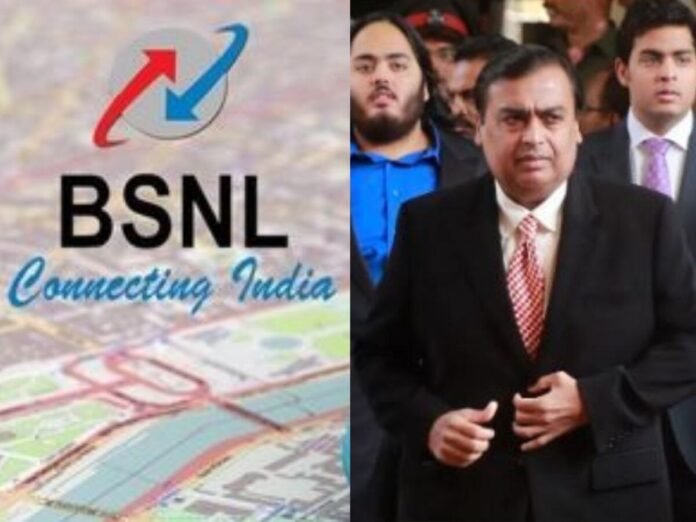The telecom industry in India has witnessed a significant shift in the competitive landscape, with Reliance Jio losing 10.9 million subscribers in a single month while Bharat Sanchar Nigam Limited (BSNL) recorded a gain of 2.9 million customers. This stark contrast underscores the impact of pricing strategies and consumer preferences in a dynamic market.
Jio’s Subscriber Loss: A Consequence of Price Sensitivity
Reliance Jio, a dominant player in the telecom sector, recently implemented a price hike across its prepaid plans, citing the need to enhance service quality and manage rising operational costs. While the increase may have been necessary for sustaining profitability, it appears to have alienated a considerable section of its customer base.
The loss of 10.9 million subscribers is a wake-up call for the telecom giant, which had built its success on affordability and widespread accessibility since its inception in 2016. Jio’s aggressive pricing strategy in its early years disrupted the market, forcing competitors to lower tariffs or exit the industry altogether. However, the recent move to raise prices has highlighted the price sensitivity of Indian consumers, many of whom prefer low-cost options over premium services.
The exodus of customers suggests that Jio’s assumption about customer loyalty might need recalibration. The company’s focus on improving average revenue per user (ARPU) by shifting towards higher-paying customers could inadvertently hurt its reputation as a cost-effective provider.
BSNL: A Revival Story in the Making
In contrast, BSNL, the state-owned telecom operator often criticized for its slow adoption of new technologies, is experiencing a resurgence. Over the past few years, BSNL has been actively working to modernize its infrastructure and expand its 4G network. This effort appears to be paying off, as evidenced by the addition of 2.9 million customers.
Several factors have contributed to BSNL’s newfound appeal. First, its relatively lower tariffs make it an attractive option for price-sensitive consumers. Second, BSNL has introduced new customer-centric plans and promotional offers that align with market demand. Third, the government’s support for BSNL, including financial aid and plans for 5G rollout, has instilled confidence among consumers.
BSNL’s growth can also be attributed to its strong rural presence, where private operators often struggle to maintain a foothold. By focusing on underserved regions and offering affordable plans, BSNL has positioned itself as a reliable alternative for users seeking basic connectivity without breaking the bank.
Market Dynamics: A Shift in Consumer Behavior
The contrasting fortunes of Jio and BSNL reflect broader trends in the Indian telecom market. The sector has seen intense competition over the last decade, with operators vying to provide better services at competitive rates. However, as the market matures, consumer behavior is shifting.
Price-sensitive users, particularly in rural and semi-urban areas, are opting for providers like BSNL, which offer value for money. Meanwhile, urban customers with higher data usage may be willing to pay a premium for reliable services and better network coverage, provided the quality justifies the cost.
This bifurcation in consumer preferences poses a challenge for telecom operators. They must strike a balance between maintaining affordability and investing in network improvements.
The Road Ahead for Jio
For Reliance Jio, the current subscriber loss is a critical moment to reassess its strategies. While the company is unlikely to reverse its price hikes, it may need to offer more segmented plans to cater to different income groups. Bundling additional services such as OTT subscriptions, cloud storage, or loyalty programs could also help retain customers.
Moreover, Jio must focus on maintaining its network quality and addressing complaints about call drops and inconsistent data speeds. With competitors like BSNL gaining traction, the need for differentiation has never been more urgent.
BSNL’s Challenges
While BSNL’s recent growth is commendable, the road ahead is fraught with challenges. The operator must accelerate its 4G and 5G deployments to stay relevant in a market increasingly dominated by high-speed data demands. Additionally, it must continue to innovate and offer competitive plans to retain its newfound customer base.
The contrasting trajectories of Jio and BSNL underscore the importance of understanding consumer priorities in a price-sensitive market like India. Jio’s subscriber loss is a reminder that affordability remains a key factor for most Indian users, while BSNL’s gains highlight the potential of catering to underserved segments.
As the telecom landscape continues to evolve, companies must adapt to changing consumer behaviors and market dynamics. For now, BSNL’s revival story and Jio’s customer exodus serve as a case study in the complexities of balancing profitability and customer satisfaction in a fiercely competitive industry.

